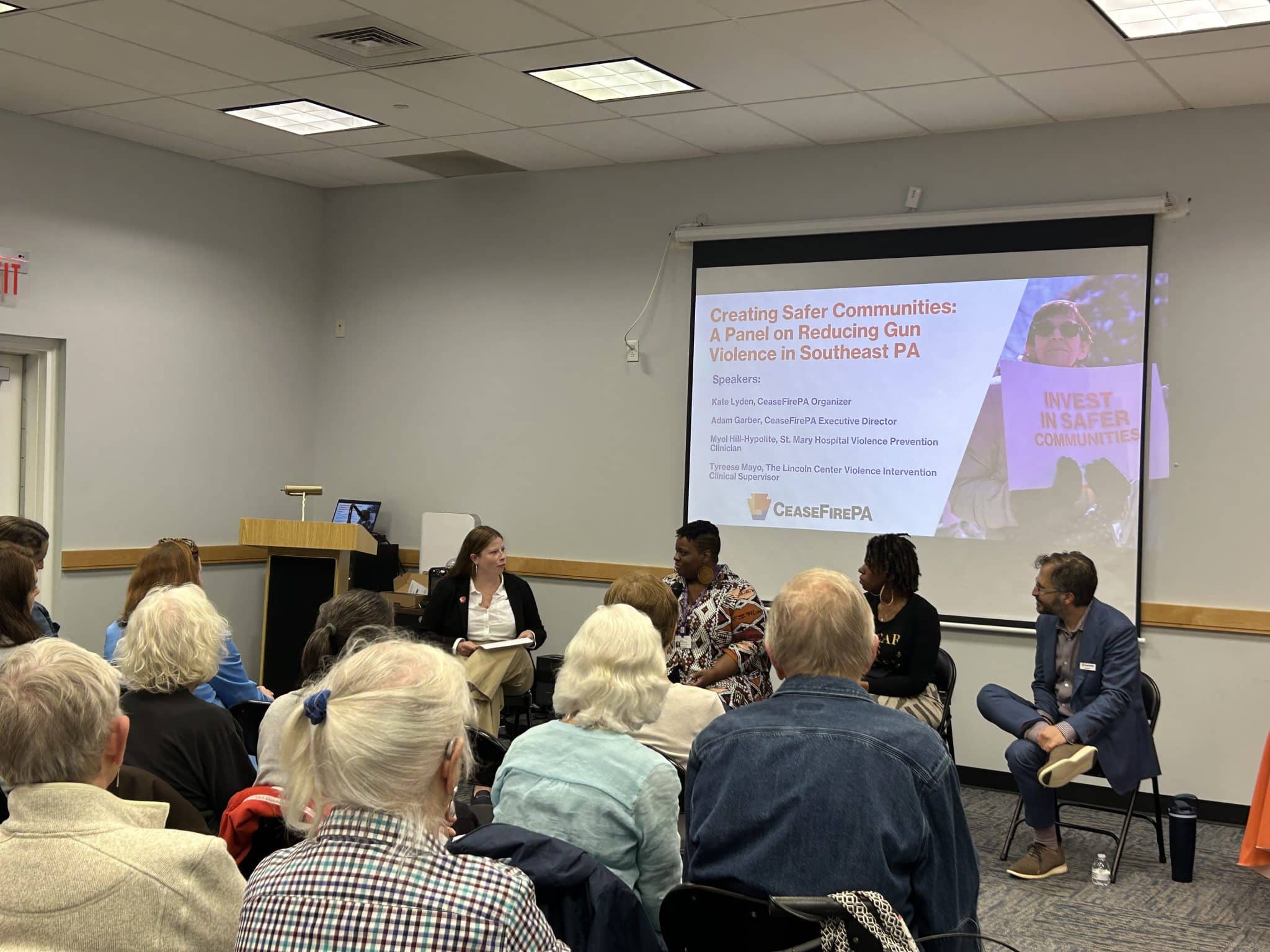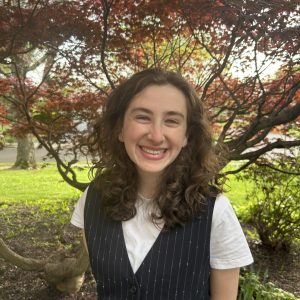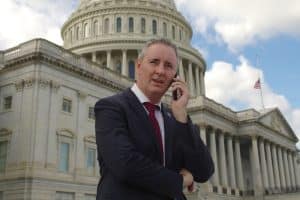In Pennsylvania, gun violence intervention programs have been proven to work, so state and local advocates are asking for more.
CeaseFirePA hosted a panel on reducing gun violence on Wedensday in Feasterville that stressed that budget decisions in Harrisburg this June could either further reduce gun homicides – or undermine Bucks County and Philadelphia-based programs that contributed to a significant drop in shootings over the last two years.
The panel was moderated by CeaseFirePA’s Southeast PA Organizer Kate Lyden and included her organinzation’s Executive Director Adam Garber, Tyreese Mayo, Violence Intervention Clinical Supervisor at the The Lincoln Center for Family and Youth, and Myel-Hill Hypolite, a Violence Prevention Clinician at St. Mary Hospital. They discussed the need for more violence intervention programs in the state and and advocated for an increase in state funding.
Before the pandemic, the state government only invested $5 million in violence intervention. Between 2019 and 2021, rates of gun deaths increased an overall 22 percent across the country. After the uptick, the state government created the Violence Intervention and Prevention Program (VIP) out of the PA Commission on Crime and Delinquency. In FY 2022-2023, the program provided $105 million VIP state and federal dollars and $75 million in federal American Rescue Plan Act (ARPA) funds to enhance community-led violence interventions and responses.
“And It worked. It did what it was supposed to do because there has been an astounding 38 percent reduction in gun homicides in Pennsylvania over the last two years,” Lyden said.
With ARPA funding being slashed in FY 2023-2024, the commonwealth has been funding the programs and steadily increasing its amount.
CeaseFirePA is now asking for a $100 million investment in the state budget for FY 2025-2026. This would be $80 million for the VIP program and $21.5 million in the BOOST program, which expands after-school time for at-risk school-age youth. As a reference, the state of Massachusetts has made the highest per capita financial investment in community violence intervention, and they consequently has the second lowest gun homicide rate, with an average of 3.7 deaths per 100,000 residents in 2025.
“Part of this work is having a truly robust, comprehensive program that touches every community with high risk for some gun violence and gun homicides,” Garber said. “And that’s gonna take that hundred million dollars.”
As for future funding, Garber said this year may be the toughest budget season he has seen in the 20 years he has lived in Pennsylvania, due to cuts to services and collective uncertainty at the federal level. As a result, funding talks have shifted to the state level. For Garber, the main funding qualifiers are the questions of prioritization and efficacy of violence intervention.
As for efficacy, according to a 2025 CeaseFirePA report, York had fewer gun homicides in 2024 than any other year since 2015, Montgomery County homicides fell 35 percent from a high in 2023, and Allentown is at its lowest rate of homicides since 1989. As to why violence intervention should be prioritized, Garber pointed to a study which correlates emergency room visits and violence exposure in youth.
“If you don’t feel safe in your community, nothing else comes next, right? We know educational attainment drops in communities with gun violence issues show that kids’ learning levels drop a whole grade level when they live near a shooting,” Garber said.
READ: Bucks County Youth Raised on Active Shooter Drills Want Sensible Gun Laws
There’s also a financial incentive to state investment. CeaseFirePA calculated that their recommended $100 million investment to prevent violence will save the commonwealth up to $500 million a year by decreasing healthcare, criminal justice system and economic costs, all while boosting tourism and business.
Garber predicts the commonwealth’s budget will get passed in early July, urging that now is the time to contact state representatives. He said that 56 Democratic state lawmakers have signed a letter to support the recommended $100 million for violence prevention which will be released next week.
“If you live in legislative districts represented by Democrats, they still need to hear from you. And if you live in Representative Hogan’s district or Representative Tomlinson’s or Senator Farry’s district, they need to hear from you,” Garber said. “Right now is the time, for the next three to four weeks, especially before the fury in the last six to seven days as they do all the writing that is going to determine if this is in it, what $50 billion will look like.”
CeaseFirePa urges doctors, nurses, healthcare professionals, and public health experts to sign their coalition letter, and any person interested in violence intervention to sign their general grassroots petition.
According to Garber, there are three key components of a violence prevention program: if the person is at risk for being involved in violence by seeing if they have had previous experiences in it, eliminating the fight or flight built-in response to counter violence with more violence, and then connecting with services.This can be addressed with Cognitive Behavioral Therapy or other types of therapy as well.
An example of a service is a credible messenger-based program, where street outreach workers trusted by and embedded in the community identify hotspots, conflict, and relationship problems.
“In Chester, one of our partners, making a change group, had gotten heads up from local law enforcement that there were threats to shoot up some local event. Law enforcement reached out to this group, and they let them know about it,” Garber said. “And they said, oh yeah, we know those folks. They were able to mediate the conflict, and deescalate the situation before it turned into a shooting.”
In Hill-Hypolite’s experience working in St. Mary’s, most of the violence she sees is domestic. Yet many cases involve firearms. One woman had 10 firearms in her home which her abusive partner had access to.
“A lot of the domestic violence people that I’ve seen that come in, they do fear that their partner has access to guns so that they’re gonna lose their life,” Hill-Hypolite said.
Mayo sees a high immigrant population in her work at the Lincoln Center, many of whom did not speak English or were undocumented. Prisoners also made up a significant chunk of clients, who were victims while being victimized.
“They were being shot at, but then they were also found with a gun, so they shackled them to the bed, cared for them, then shipped them off to also charge them with possession,” Mayo said.
Being close to West Philadelphia, Mercy Fitzgerald Hospital, a hospital involved in the grant partnership, sees many gunshot victims with referrals from other hospitals in the city. Mercy Fitzgerald provides longer-term services after the initial wound is treated.
“But a lot of times they’re not coming to our hospital, so we’ve had to do a really good job of building relationships so that those individuals know that we’re there to try to give them the resources and guidance to help them identify other ways of protecting themselves,” Mayo said.
As a clinical counselor, Hill-Hypolite sometimes helps people through the program for a whole year, aiding with personal trauma.
“We don’t just treat their injury on the surface – we go into a deeper, deeper feeling,” Hill-Hypolite said.







